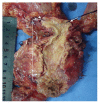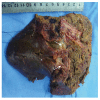Resection of a cholangiocarcinoma via laparoscopic hepatopancreato- duodenectomy: a case report
- PMID: 25493044
- PMCID: PMC4258600
- DOI: 10.3748/wjg.v20.i45.17260
Resection of a cholangiocarcinoma via laparoscopic hepatopancreato- duodenectomy: a case report
Abstract
Some laterally advanced cholangiocarcinomas behave as ductal spread or local invasion, and hepatopancreatoduodenectomy (HPD) may be performed for R0 resection. To date, there have been no reports of laparoscopic HPD (LHPD) in the English literature. We report the first case of LHPD for the resection of a Bismuth IIIa cholangiocarcinoma invading the duodenum. The patient underwent laparoscopic pancreaticoduodenectomy and right hemihepatectomy. Child's approach was used for the reconstruction. The patient recovered well with bile leakage from the 2(nd) postoperative day and was discharged on the 16(th) postoperative day with a drainage tube in place which was removed 2 wk after discharge. Postoperative pathology revealed a well-differentiated cholangiocarcinoma and the margin of liver parenchyma, pancreas and stomach was negative for metastases. The results suggest that LHPD is a feasible and safe procedure when performed in highly specialized centers and in suitable patients with cholangiocarcinoma.
Keywords: Cholangiocarcinoma; Hemihepatectomy; Hepatopancreatoduodenectomy; Laparoscopic surgery; Pancreaticoduodenectomy.
Figures





Similar articles
-
Laparoscopic hepatopancreaticoduodenectomy for synchronous gallbladder cancer and extrahepatic cholangiocarcinoma: a case report.World J Surg Oncol. 2022 Jun 9;20(1):190. doi: 10.1186/s12957-022-02628-9. World J Surg Oncol. 2022. PMID: 35681223 Free PMC article.
-
Hepatopancreatoduodenectomy for cholangiocarcinoma: a single-center review of 85 consecutive patients.Ann Surg. 2012 Aug;256(2):297-305. doi: 10.1097/SLA.0b013e31826029ca. Ann Surg. 2012. PMID: 22750757
-
Hepatopancreatoduodenectomy could be allowed for patients with advanced intrahepatic cholangiocarcinoma.Hepatogastroenterology. 2007 Mar;54(74):346-9. Hepatogastroenterology. 2007. PMID: 17523271
-
Review of hepatopancreatoduodenectomy for biliary cancer: an extended radical approach of Japanese origin.J Hepatobiliary Pancreat Sci. 2014 Aug;21(8):550-5. doi: 10.1002/jhbp.80. Epub 2014 Jan 27. J Hepatobiliary Pancreat Sci. 2014. PMID: 24464987 Review.
-
Laparoscopy in the management of hilar cholangiocarcinoma.World J Gastroenterol. 2014 Nov 7;20(41):15153-7. doi: 10.3748/wjg.v20.i41.15153. World J Gastroenterol. 2014. PMID: 25386064 Free PMC article. Review.
Cited by
-
Laparoscopic hepatopancreaticoduodenectomy for synchronous gallbladder cancer and extrahepatic cholangiocarcinoma: a case report.World J Surg Oncol. 2022 Jun 9;20(1):190. doi: 10.1186/s12957-022-02628-9. World J Surg Oncol. 2022. PMID: 35681223 Free PMC article.
-
Intracorporeal esophagojejunostomy after totally laparoscopic total gastrectomy: A single-center 7-year experience.World J Gastroenterol. 2016 Mar 28;22(12):3432-40. doi: 10.3748/wjg.v22.i12.3432. World J Gastroenterol. 2016. PMID: 27022225 Free PMC article.
-
LDP vs ODP for pancreatic adenocarcinoma: a case matched study from a single-institution.BMC Gastroenterol. 2015 Dec 22;15:182. doi: 10.1186/s12876-015-0411-2. BMC Gastroenterol. 2015. PMID: 26695506 Free PMC article.
-
Laparoscopic versus open pancreatic resection for ductal adenocarcinoma: separate propensity score matching analyses of distal pancreatectomy and pancreaticoduodenectomy.BMC Cancer. 2021 Apr 9;21(1):382. doi: 10.1186/s12885-021-08117-8. BMC Cancer. 2021. PMID: 33836678 Free PMC article.
-
Laparoscopic hepatopancreatoduodenectomy for synchronous intrahepatic and extrahepatic cholangiocarcinoma: A case report.Oncol Lett. 2023 Aug 31;26(4):449. doi: 10.3892/ol.2023.14036. eCollection 2023 Oct. Oncol Lett. 2023. PMID: 37720678 Free PMC article.
References
-
- Cai X, Li Z, Zhang Y, Yu H, Liang X, Jin R, Luo F. Laparoscopic liver resection and the learning curve: a 14-year, single-center experience. Surg Endosc. 2014;28:1334–1341. - PubMed
-
- Kendrick ML. Laparoscopic and robotic resection for pancreatic cancer. Cancer J. 2012;18:571–576. - PubMed
-
- Ebata T, Yokoyama Y, Igami T, Sugawara G, Mizuno T, Nagino M. Review of hepatopancreatoduodenectomy for biliary cancer: an extended radical approach of Japanese origin. J Hepatobiliary Pancreat Sci. 2014;21:550–555. - PubMed
-
- Miwa S, Kobayashi A, Akahane Y, Nakata T, Mihara M, Kusama K, Ogawa S, Soeda J, Miyagawa S. Is major hepatectomy with pancreatoduodenectomy justified for advanced biliary malignancy? J Hepatobiliary Pancreat Surg. 2007;14:136–141. - PubMed
Publication types
MeSH terms
LinkOut - more resources
Full Text Sources
Other Literature Sources
Medical

